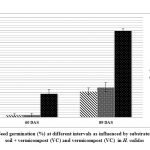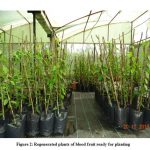Introduction
Blood fruit (Haematocarpus validus (Miers.) Bakh. f. ex Forman) is a liana of Menispermaceae family that bears edible fruits in grape like bunches. The species has been identified as a novel source of natural colourant, Pelargonidin and Cyanidin being the dominant compounds responsible for its colour.1 Considering potential of this species as a fresh fruit, natural colourant, source of bioactive compounds and as a viable source of income for local people, it being promoted as a novel crop in the Andaman and Nicobar Islands.1-3
However, forests are the major source of blood fruit for local people in native regions and its natural populations have been threatened due to manmade and natural calamities. In order to conserve the species, seed pretreatment for improving seed germination was standardized.2 Seed germination being a complex process involving various internal and external factors, efforts are required to optimize these factors to maximize the regeneration efficiency of the technique. Nursery substrate has been reported to influence germination process significantly.4-5 Thus, present investigation aimed at studying the effect of substrates in nursery raising of blood fruit.
Materials and Methods
Mature fruits of blood fruit were collected from fruits and vegetables market of Diglipur, North Andaman and brought to authors’ Institute. Fruits were allowed to ripe naturally at ambient temperature and fully ripe fruits were used for experiment. Seeds were manually extracted from the fruits and washed thoroughly to remove adhering pulp. Seeds were, then, soaked in the solution of thiourea (0.1%) for 24 h as described earlier.2 Three substrates viz. sand, vermicompost (VC) and red soil + vermicompost (1:1, v/v) were used to study their effect on seed germination and seedling vigour.
Root trainers were filled with the said substrates and treated seeds were sown at 2 cm depth. Watering was done regularly to maintain adequate moisture in the substrate. Observations on germination were recorded at 60 and 89 days after sowing (DAS). Ten seedlings were selected from each treatment for recording seedling growth parameters such as shoot length (cm), no. of leaves per seedling, no. of primary roots per seedling, mean root length (cm), collar thickness (cm), intermodal length (cm) and seedling length (cm). Seedling vigour index (SVI) was calculated as a product of percent germination in the treatment and mean seedling length (cm).
The experiment was carried out in completely randomized design with seven replications, each replication with thirty seeds. Thus, a total of 630 seeds were used. Data were subjected to analysis of variation using Web Agri Statistical Package (WASP 2.0) and mean separation was performed using least significant difference.
Results and discussion
Several external and internal factors are known to influence the process of seed germination. Our previous study in blood fruit2 helped identification of suitable seed pre-treatments. In order to study the effect of substrate on seed germination, present study was carried out using three substrates. Perusal of data suggested that germination process in blood fruit was significantly influenced by type of substrate during initial observation period (Fig. 1). Use of VC as substrate promoted early seed germination as highest germination percentage (19.0%) was observed in this treatment at 60 DAS, which was tenfold higher than seeds sown in sand or VC+ soil substrates (1.9%).
 |
Figure 1: Seed germination (%) at different intervals as influenced by substrates viz. |
At 89 DAS, similar trend was observed in these treatments and highest germination of 69.5% was reported, when seeds were sown in VC. Germination percentage in other two substrates remained comparable with each other (21.0 to 24.3%). Apart from high nutrient content, vermicompost is known to have high moisture holding capacity.6 Process of germination requires a definite level of moisture and temperature of substrate to obtain optimum germination.7 Vermicompost might have provided these factors at optimum level, thereby stimulating germination in blood fruit. Presence of some humic substances in the vermicompost is known to have effects similar to hormones and thereby promote plant growth.8-9 As the best seed pre-treatment (thiourea)2 was used for improving seed germination in the present study, it would have facilitated better sprouting of seeds. Such sprouted seeds would have got easy access to available nutrients and moisture present in the VC substrate. Positive effects of vermicompost on promotion of seed germination and plant growth have been reported by earlier researchers.8-9 Sand, on the other hand, is devoid of the nutrients, while red soil used with VC is also known for its poor nutrient content. Interestingly, statistically similar germination response in distinctly different substrates i.e. sand and soil + VC require further studies to understand the seed behavior in these substrates. In wild banana species- Musa indandamanensis and M. paramjitiana, interaction effect of substrate and chemical treatment have been reported as same pre-treatment showed variable germination in different substrates.4-5
Even though germination percentage at 89 DAS was significantly superior in VC treatment, data suggested that regenerated seedlings in other treatments grew equally well (Table 1) as on par values were noticed for most of the growth parameters studied. Parameters such as shoot length (62.2-69.1 cm), no. of primary roots per seedling (17.1 – 25.6), root length (9.6- 12.0 cm), collar thickness (0.2 cm), intermodal length (7.5- 7.9 cm) and seedling length (73.8 – 78.7 cm) did not differ significantly among the substrates studied. However, the highest number of leaves per seedling (7.8) was noticed in VC substrate, while as low as 5.7 leaves were produced when sand was used as substrate.
Table 1: Seedling growth parameters and seedling vigour index in H. validus as influenced by substrates viz. sand, soil + vermicompost (VC) and vermicompost
|
Substrate |
Sand |
Soil + VC |
VC |
|
Shoot length (cm) |
62.9 ± 5.95a |
62.2 ± 2.89a |
69.1 ± 4.51a |
|
No. of leaves |
5.7 ± 0.26b |
6.3 ± 0.42b |
7.8 ± 0.71a |
|
No. of primary roots |
25.6 ± 3.96a |
17.1 ± 1.54a |
19.0 ± 1.18a |
|
Root length (cm) |
10.9 ± 1.10a |
12.0 ± 0.65a |
9.6 ± 0.47a |
|
Collar thickness (cm) |
0.2 ± 0.01a |
0.2 ± 0.02a |
0.2 ± 0.00a |
|
Internodal length (cm) |
7.6 ± 0.41a |
7.5 ± 0.35a |
7.9 ± 0.63a |
|
Seedling length (cm) |
73.8 ± 5.37a |
74.2 ± 3.05a |
78.7 ± 4.52a |
|
Seedling vigour index |
1549.4 ± 112.69b |
1803.5 ± 74.16b |
5466.9 ± 314.15a |
Value followed by similar alphabet in a row do not differ significantly using least significant differences at 5% level of significance
Seedling vigour index is the product of germination (%) and seedling growth. Hence, both these parameters have direct influence on SVI. Due to poor germination response at 89 DAS in sand and VC + soil substrates, values for SVI were as low as 1549.4 and 1803.5 in these treatments, respectively, while SVI (5466.9) in VC substrate was significantly the highest (Table 1). It also means that though less germination was observed in the sand and VC + soil treatments, the regenerated seedlings had comparable growth and germination percentage was the only factor causing variations in the SVI. Considering the superior germination characteristics in VC, it could be recommended as a substrate for seed germination in blood fruit. Regenerated seedlings were transplanted in polybags filled with soil: FYM (3:1; v/v) and kept for hardening in polyhouse before field planting (Fig.2).
 |
Figure 2: Regenerated plants of blood fruit ready for planting |
Acknowledgement
Authors are thankful to the Director for providing necessary facility for conducting the study. Thanks are also due to DBT, New Delhi for providing financial support in the form of DBT-BioCARe (19575).
Conflict of interest
Authors declare that they have no conflict of interest.
Funding Source
Authors are thankful to the Director for providing necessary facility for conducting the study. Thanks are also due to DBT, New Delhi for providing financial support in the form of DBT-BioCARe (19575).
References
- Bohra P., Waman A.A., Roy T.K., Shivashankara K.S. Blood fruit (Haematocarpus validus (Miers.) Bakh. f. ex Forman): a novel source of natural food colourant. J Food Sci Technol, 2020b; 57(1):381–389.
- Bohra P., Waman A.A., Basantia D., Devi H.L., Reang E. Domestication and conservation efforts in Haematocarpus validus (Miers.) Bakh. f. ex Forman (Menispermaceae): an underutilized fruit species and natural colourant. Curr Sci, 2018; 115:1098–1105.
- Singh D.R., Singh S., Shajeeda Banu V. Estimation of phytochemicals and determination of beta carotene in Haematocarpus validus, an underutilized fruit of Andaman and Nicobar Islands. Eur J Env Ecol, 2014; 1:12–15.
- Bohra P, Waman AA, Jerard BA. Accelerating regeneration of threatened wild banana (Musa paramjitiana L.J. Singh) endemic to Andaman and Nicobar Islands, India. Curr Sci, 2019; 116:1792–1794.
- Bohra P., Waman A.A., Jerard B.A. Seed germination and storage studies in seed-fertile Musa indandamanensis and its conservation. S Afr J Bot, 2020a; 128:161-166.
- Marinari S., Masciandaro G., Ceccanti B., Grego S. Influence of organic and mineral fertilisers on soil biological and physical properties. Bioresour Technol, 2000; 72:9–17.
- Wagenvoort W.A. Seed germination as affected by soil type and soil moisture. Acta Hortic, 1981; 119:293-297.
- Arancon N.Q., Edwards C.A., Lee S., Byrne R. Effect of humic acids from vermicompost on plant growth. Eur J Soil Biol, 2006; 42:S65–S69.
- Atiyeh R.M., Dominguez J., Subler S., Edwards C.A. Changes in biochemical properties of cow manure during processing by earthworms (Eisenia andrei, Bouche) and the effects on seedling growth. Pedobiologia, 2000; 44:709–724.

